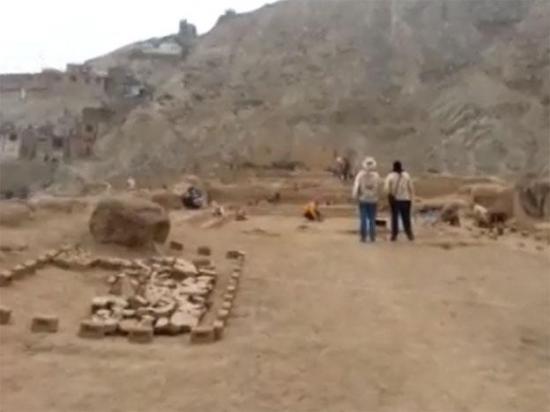Rachel Chase
Source - http://www.peruthisweek.com/news-archaeologists-make-significant-progress-at-the-huaca-monterrey-in-lima-peru-101467
Archaeologists report finds of sophisticated architecture, well-preserved textiles, and funerary offerings.

(Photo: Screencap from El Comercio video by Luis García Bendezú)
Like many of Lima’s huacas, the Huaca Monterrey isn’t much to look at from the outside: sandy, lumpy, and generally an archaeological letdown in a country with such monumental sites such as Chan Chan and Machu Picchu. Surrounded by houses and urban activity, the Huaca Monterrey is located in the working class district of Ate, in Lima.
However, archaeologists working in the area have made a number of important finds that are leading experts and local residents alike to reevaluate their ideas about the site.
According to El Comercio, the Huaca Monterrey dates back to about 1300 AD, when it was constructed by members of the Ichma culture. The site reached its peak around 1470, when the Ichma had been absorbed into the Inca empire. The site is divided into two sectors (called Monterrey I and Monterrey II), and archaeologists are currently undertaking extensive excavation in Monterrey I.
El Comercio reports that excavations at the Huaca Monterrey have revealed much more complex architecture than was originally expected. Archaeologist Julio Abanto, who is leading the dig, said “Monterrey has maze-like architecture, with narrow passages, dark, and zig-zags. They weren’t streets for normal use, but reserved for a political or religious elite.”
In addition to architectural finds, excavators have found Inca textile goods, including a shirt with feather decorations. Andina news agency reports that other finds include fine ceramics and spondylus shells, which were brought to the area from Ecuador.
The complex was used even after the Spaniards arrived in Peru, but not for long. Abanto told El Comercio that “Once the colonial era started, the area was used as a cemetery. After that, it was abandoned, and then there was a large flood.”
In more recent years, the huaca and the surrounding area have been used for a number of purposes. Much to archaeologists’ dismay, the huaca has been used variously as a dump, a fulbito court, a latrine, and a smoking den.
According to El Comercio, the residents of Ate who live near the huaca are largely migrants from the mountainous rural areas of the country, who fled their provincial homes during the years of terrorism. One of the most notable aspects of this project is that excavators have worked to involve members of the local community.
Local government official Claudio Villarroel told El Comercio that “We really didn’t think that the huaca could be worth anything. Now some of the young people that were gang members are working on the restoration.” El Comercio reports that 16 archaeologists and 30 laborers, many of whom live in the area surrounding the huaca, are working on the excavation.
Director of Heritage Archaeological Sites of the Ministry of Culture Luis Caceres Rey said “Lots of people think that huacas are dumps because there hasn’t been any involvement. We want to change that vision. The local residents are the people who will benefit the most from the restoration.”
According to Caceres, there are 366 huacas in Lima alone, but 90% of them are in need of restoration. The Huaca Monterrey project represents an investment of S/. 1,156,610 by the Ministry of Culture.
Huaca (sometimes written as “waka”) is a Quechua word that signifies a holy place but is now commonly used to refer generally to archaeological sites in Peru.